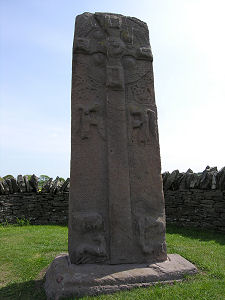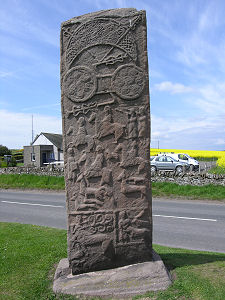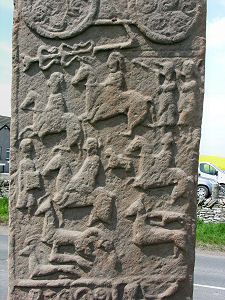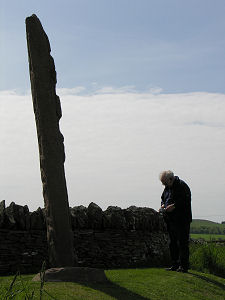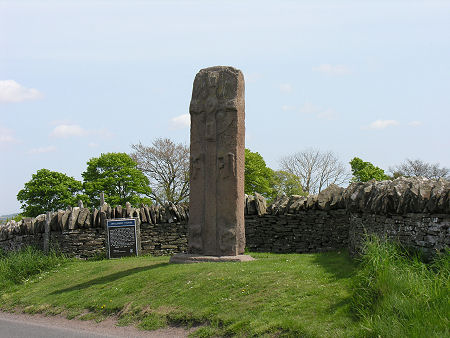 The Aberlemno Roadside Cross Slab |
Pictish Symbol Stones open a small window into an era of Scottish history which, though lasting over three centuries and ending at a time when written records were appearing elsewhere on these islands, is little understood.
What were Pictish Symbol Stones for? What were the symbols on them intended to represent? After Christianity had come to Pictland, it was increasingly common for one side of Pictish stones to carry a carving of a cross, but little headway has been made in understanding the wide range of other symbols that adorned early stones, and which continued to appear on the rear of stones whose front faces carried crosses.
Symbol stones have often turned up in groups, and one such group occurs around the tiny settlement of Aberlemno, approximately mid way between Forfar and Brechin on the B9134. It may be significant that the Pictish stronghold on the Hill of Finavon is nearby. Or it might simply be that the line now taken by the B9134 follows a ridge that provided a natural route across this part of Pictland.
In all, six Pictish stones have turned up in or around Aberlemno, four of which remain on view. One stands in the kirkyard of Aberlemno Kirk, and we cover this stone and the kirk in a separate feature. The three others stand, each a short distance from the next, slightly set back from the south side of the main road. You should leave your car in the car park next to the village hall, which stands on the north side of the main road opposite the largest of the stones. From here you make your way to each of the stones in turn. In the absence of a pavement this means repeated excursions into the road itself, so considerable care is required.
Protecting old stones like these is an issue that increasingly taxes conservationists, and for some time there has been discussion of the possibility of removing these roadside stones to a purpose-built shelter next to the village hall. In the meantime, the stones are covered in wooden packing to protect them from the elements from October to March each year: which means, of course, that they can't be seen by visitors.
The most impressive of the roadside stones in Aberlemno is the cross slab, or "Aberlemno 3". This stands 2.8m high by 1.0m wide by 0.3m deep. The west side of this stone, facing the road, carries a deeply carved cross. The angles of the cross carry carved bosses, while a more highly raised boss forms the centre of the cross. The carving has been carried out to make the cross look as if it had been fashioned from metal, something that characterises many Pictish carved crosses. A little down the stone, the shaft of the cross has an angel on either side, each shown carrying a bible and bowing towards the cross. The base of the front of the stone carries less gentle images. To the left of the foot of the cross one animal is attacking another, while on the other side an animal is attacking a man.
The rear of the cross slab is divided vertically into three distinct sections. The upper 35% of the stone carries highly intricate renditions of standard Pictish symbols. These are a "crescent and V-rod" and a "double disc and Z-rod". The names are simply intended to describe the patterns, and no-one knows whether such symbols signify the rank of some individual, the clan of those living in the area, or something else entirely. The next 40% of the stone carries a side-on depiction of a hunting scene. This includes four mounted hunters, deer and hounds, two trumpeters, and a man carrying a spear and a square shield. The lowest 25% of the stone carries biblical images, notably David and the lion.
The cross slab is the most southerly of the three stones beside the road. The most northerly is 1.8m high by 0.9m wide and leans at a significant angle to the side. This is known as "Aberlemno 1". It is believed to be the oldest of the stones at Aberlemno and the side facing the road carries a series of Pictish symbols. These include a "double disc and Z-rod", like the rear of the cross slab, though in a very much older and simpler style. This face of the stone also carries a carving of a snake, and of a mirror and comb. Carvings of mirrors and combs are another common feature, and sometimes thought to tie in with memorials to important female members of Pictish society, though this is little more than guess-work. It is thought this stone might stand in its original location, and in the 1800s, an antiquarian uncovered a cairn nearby and remnants of human bones and stone coffins from the field behind. The rear of this stone is rough-cast and seems to carry some prehistoric cup-and-ring marks near its base. It is possibly the Picts simply smoothed down one face of an existing prehistoric standing stone before carving on it.
The middle of the three stones leaves you wondering whether someone has substituted a sandstone stump for the real thing. It is said to have originally carried symbols like those on the more northerly stone, but if it did, they have eroded to invisibility in the meantime.
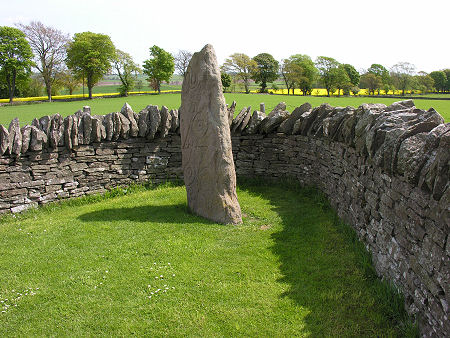 The Northern Roadside Symbol Stone |

|
|
|
Visitor InformationView Location on MapGrid Ref: NO 523 559 www.historicenvironment.scot HES: Aberlemno Web Page What3Words Location: ///turned.punctured.variety |
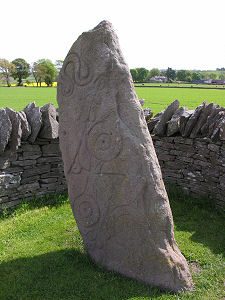 Northern Roadside Symbol Stone |
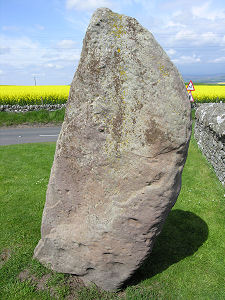 Rear of the Northern Symbol Stone |
 The Central Roadside Stone |
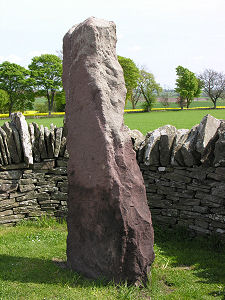 Closer View of the Central Stone |
